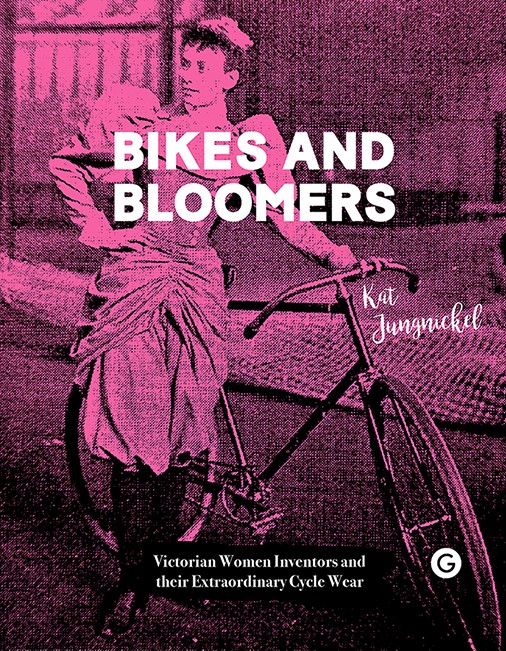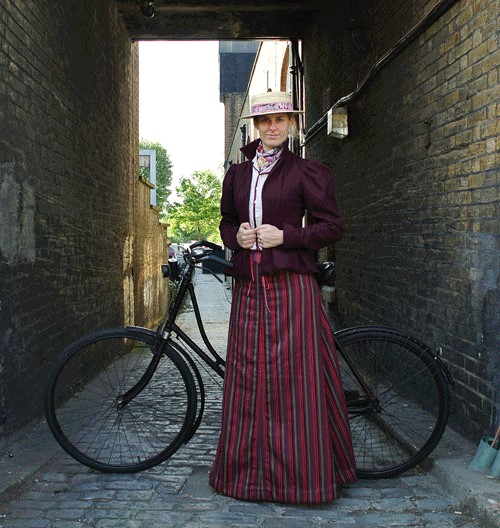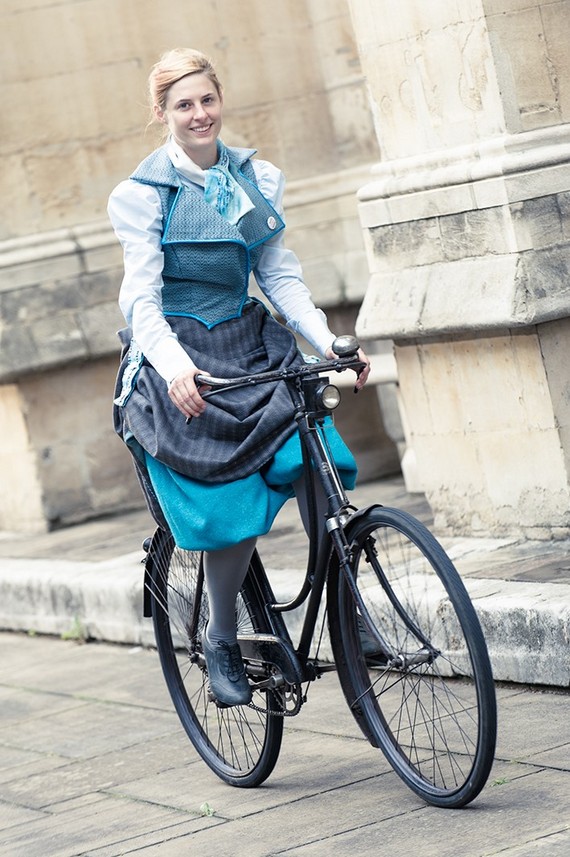Review – Bikes and Bloomers by Dr Kat Jungnickel
June 27, 2018Bikes and Bloomers is an exciting book about female Victorian cyclists and inventors. Can you imagine hopping on your bike in your jeans for an errand and having people shout abuse at you? This was just normal for the earliest female cyclists. The ridicule came from both the idea of a lady riding a bike – and for wearing bloomers whilst at it. Crazy right?
It took the activities of a few determined women who insisted on riding their bikes in public, and in riding them in the safest and most convenient clothing to get us to this point. Isn’t it strange to think that something that was worn by a tiny percent of the population just over a hundred years ago is now the most common clothing of the Western world?

Front cover of Bikes and Bloomers Book by Dr Kat Jungnickel


Author of Bikes and Bloomers Dr Kat Jungnickel, a keen cyclist, academic and feminist decided to use the subject of convertible cycle wear for women in the late nineteenth century to look at ideas around, essentially, the policing of women’s bodies (and minds), then and even now. As we know, the bicycle is a Victorian invention. Think of those quintessentially Victorian illustrations of men in top hats, precariously balanced atop a Penny Farthing. The Penny Farthing looks impossibly quaint, but it was followed by a line of modifications and inventions until, only a few years later, “The Ordinary” appeared – a very recognisably modern bike. It was essentially the same design as today with two equal sized wheels and a diamond frame.
A Modern Bicycle
The Ordinary was much less expensive than the penny farthing, safer, and, of course, easier to store. They became extremely popular. These machines were speedy, exciting, daredevil contraptions, to be skilfully mastered and manoeuvred. Therefore, they were not for women.
Yet women wanted in. But what about their health? the experts cried. Women only had a limited supply of energy throughout their lifetimes, they said, and it was unthinkable to squander this on anything else but childbirth.
But women weren’t put off. They recognised the freedoms of the bicycle, to get to places quickly and inexpensively. Moreover it was fun.
Bikes and Bloomers – First Run
Many determined women bought a bicycle and took their first rides. Yet, mastering a new technology wasn’t the only thing they might to be nervous about. “You needed nerves of iron” to ride through a town, as one keen lady cyclist wrote. Not because the learning curve, but because of the comments. Men of all classes hurled insults at them.
And it didn’t help that even the most skilful cyclist was hampered by long skirts, corsets, and bikes that were heavier, with less choice of sizing to fit them, and several steps behind the latest innovation than the male versions available at the time.
Such a popular item as the bicycle was constantly being innovated, especially in this time of inventions. The patents system was concurrently overhauled and made cheaper to keep inventions flowing, in order that Britain keep her crown as the most civilised and up to date country, particularly now there was stiff competition from America.
Convertible Outfits
Therefore, amongst all the improvements and innovations of cycling, women decided to create clothes to ride in that could be disguised. Something that looked like an ordinary walking costume and could be converted into a more practical outfit in a jiffy.
Kat is an ethnographist, which would normally involve her speaking to her subjects of study. However, you can’t interview a long dead person, so instead in Bikes and Bloomers she “interviews” the patent, by making the clothes described. Only by making them can you quite understand what they describe, and you can understand even more by wearing them.
Although the patents contain descriptions, sketches of the finished article and sketches of the pattern pieces, the process of making the garments described gave the several pattern cutters and sewing experts in the team quite a challenge: each needed a scale model, toile, mock-up and final garment before it was finished. Instructions were sometimes vague too, probably either because the person doing the describing had never had to describe a garment process before or, on the contrary, they were skilled dressmakers and thought that what they were saying was perfectly obvious.
Bikes and Bloomers – Trying it Out
The results for Bikes and Bloomers in general look good, although I very much wish that the team had forebore from adding a final touch – a specially commissioned illustrator who designed a lining fabric which is completely anachronistic, looks to be the wrong weight, and is unfortunately rather garish. It’s true that Victorian women were often fond of a bright colour, but, sadly, these bright colours and prints don’t go with the project at all.
Making the clothes up is a great idea, as is having contemporary women try them out. In Bikes and Bloomers, Kat has taken these reconstructions on talks and events around the country and the thoughts of other seasoned cyclists who try them on has given her even more insight. In fact, it was just the same for the original inventors, manufacturers and sellers of these garments – they were not only illustrated and described, but often demonstrated by lady models at events. In addition, of course, you could go and try them on, and some shops even provided stationary bicycles to see how they felt in the saddle. At the height of the craze, when cycling shops had increased tenfold in some high streets, one shop chose to get ahead of the competition by offering customers actual bikes and an indoor riding space to really feel how they performed at speed.
Bikes and Bloomers – Famous Female Riders
Not that lady riders were supposed to go at speed, even in a specially designed cycling outfit. Although it was a very popular practice, lots of articles were written deploring women who showed effort when riding, getting red in the face or even sweaty. The idea, many suggested, was to look as elegant as possible, remaining upright with good comportment, unflustered, well dressed and perfectly coiffed. Even many magazines and campaigning bodies which promoted women cyclists advised this. This was similar to advice to Suffragists to remain unimpeachably neat and well-groomed in order to deflect criticism, on the basis that if you looked like a perfect lady you couldn’t possible be doing anything unladylike.
The story behind the inventions are fantastic. In Bikes and Bloomers, Kat doesn’t just reconstruct the clothes, she delves into the story of the inventor. Some are well documented. Alice Bygrave was from Brixton and first sold her patent to the Jaegar company before took her invention to America and selling it for $5000. Even more interesting, perhaps, is the story of her sister-in-law, Rosine, who was a professional racer earning a living wage in the velodrome. Rosine modelled Alice’s skirt in publicity photos. Interesting too is the life of Suffragist and women’s rights campaigner Henrietta Muller. Both of their inventions were effective, too. However, Kat also tells the story in Bikes and Bloomers of several other inventions that may never have been realised, were less effective or whose inventors were harder to trace in order to tell the fuller story.
It’s a fascinating premise for a book and research project and a great read for those interested in fashion, cycling, or both.
Bikes and Bloomers by Dr Kat Jungnickel is available from several good bookshops.